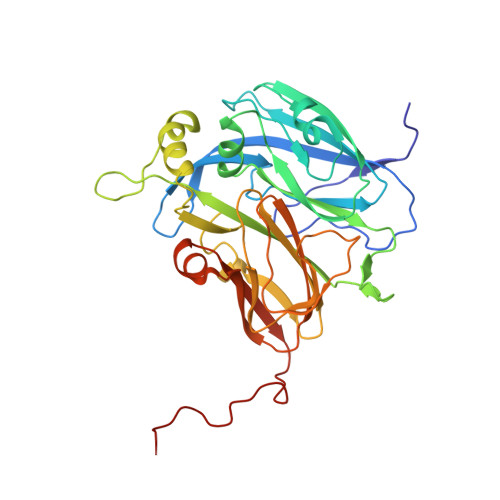Spectroscopically Validated pH-dependent MSOX Movies Provide Detailed Mechanism of Copper Nitrite Reductases.
Rose, S.L., Ferroni, F.M., Horrell, S., Brondino, C.D., Eady, R.R., Jaho, S., Hough, M.A., Owen, R.L., Antonyuk, S.V., Hasnain, S.S.(2024) J Mol Biol 436: 168706-168706
- PubMed: 39002715
- DOI: https://doi.org/10.1016/j.jmb.2024.168706
- Primary Citation of Related Structures:
8R8S, 8RFL, 8RFO, 8RFP, 8RFQ, 8RFR, 8RFS, 8RFT, 8RFU, 8RFV, 8RFW, 8RFX, 8RFY, 8RG8, 8RG9, 8RGB, 8RGC, 8RGD, 8RU9, 8RUR, 8RYJ, 8RYR, 8RYU, 8RYV, 8S0W, 8S2Q, 8S5X, 8S5Y, 8S63, 8S64, 8S68, 8S69, 9EVM - PubMed Abstract:
Copper nitrite reductases (CuNiRs) exhibit a strong pH dependence of their catalytic activity. Structural movies can be obtained by serially recording multiple structures (frames) from the same spot of a crystal using the MSOX serial crystallography approach. This method has been combined with on-line single crystal optical spectroscopy to capture the pH-dependent structural changes that accompany during turnover of CuNiRs from two Rhizobia species. The structural movies, initiated by the redox activation of a type-1 copper site (T1Cu) via X-ray generated photoelectrons, have been obtained for the substrate-free and substrate-bound states at low (high enzymatic activity) and high (low enzymatic activity) pH. At low pH, formation of the product nitric oxide (NO) is complete at the catalytic type-2 copper site (T2Cu) after a dose of 3 MGy (frame 5) with full bleaching of the T1Cu ligand-to-metal charge transfer (LMCT) 455 nm band (S(σ) Cys → T1Cu 2+ ) which in itself indicates the electronic route of proton-coupled electron transfer (PCET) from T1Cu to T2Cu. In contrast at high pH, the changes in optical spectra are relatively small and the formation of NO is only observed in later frames (frame 15 in Br 2D NiR, 10 MGy), consistent with the loss of PCET required for catalysis. This is accompanied by decarboxylation of the catalytic Asp CAT residue, with CO 2 trapped in the catalytic pocket.
Organizational Affiliation:
Molecular Biophysics Group, Life Sciences Building, Institute of Systems, Molecular and Integrative Biology, Faculty of Health and Life Sciences, University of Liverpool, Liverpool L69 7ZB, United Kingdom.



















